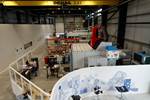Purdue, Thermwood explore the acceleration of composites manufacturing through 3D printing
A video interview highlights how the university, the CAMS Consortium and Thermwood’s LSAM technology have enabled first-time-right production.
Share
Read Next
Source | Thermwood
Purdue University’s (West Lafayette, Ind., U.S.) (CMSC) and Thermwood Corp. (Dale, U.S.) have joined forces to merge predictive simulation with large-scale 3D printing, enabling “first-time-right” production of advanced composite parts.
In an interview, Purdue’s Dr. Byron Pipes and Dr. Eduardo Barocio share how this collaboration between the university, the CAMS Consortium and Thermwood’s large-scale additive manufacturing (LSAM) technology is redefining how research moves from the lab to the factory floor. The result? Faster development, reduces costs and stronger, more complex structures. From advancing large-scale 3D printing to developing simulation-driven software tools, this partnership aims to accelerate innovation and transform how research translates into real-world industrial solutions.
Some key insights from the interview address:
- Why digital simulation is the key to unlocking the full potential of additive manufacturing
- How LSAM technology helps bridge the gap between research and production
- The impact of collaborative research on the future of composite materials for aerospace, automotive and defense
“It is one of the most exciting problems I’ve worked on,” says Pipes during the interview. “Thermwood is innovative from the very top. Some of the smartest people I’ve ever met work in this organization.”
Access the complete interview in the video below or on .
Related Content
-
Reinforcing hollow, 3D printed parts with continuous fiber composites
Spanish startup Reinforce3D’s continuous fiber injection process (CFIP) involves injection of fibers and liquid resin into hollow parts made from any material. Potential applications include sporting goods, aerospace and automotive components, and more.
-
Low-cost, efficient CFRP anisogrid lattice structures
CIRA uses patented parallel winding, dry fiber, silicone tooling and resin infusion to cut labor for lightweight, heavily loaded space applications.
-
Otto Aviation launches Phantom 3500 business jet with all-composite airframe from Leonardo
Promising 60% less fuel burn and 90% less emissions using SAF, the super-laminar flow design with windowless fuselage will be built using RTM in Florida facility with certification slated for 2030.






